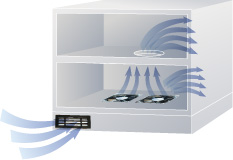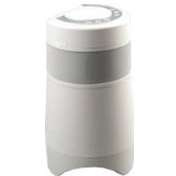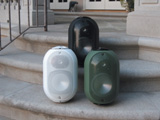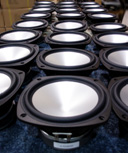|
Active Thermal - System 4 Enclosure Cooling System, which requires only one opening in a cabinet
 For the first time, there is an effective enclosure cooling system that needs only ONE small opening for fresh air intake -- and NO additional openings for exhaust! This one will solve many problems for you and your clients when there's just no other way to do the job! For the first time, there is an effective enclosure cooling system that needs only ONE small opening for fresh air intake -- and NO additional openings for exhaust! This one will solve many problems for you and your clients when there's just no other way to do the job!
The System 4 is comprised of a new motor assembly (the "six-pack"), a two-speed thermal controller, and either a metal or wood intake grille. (There is a "no grille" version for cabinets on legs, which need no additional opening for intake.)
The intake grille is installed in a small hole cut in the toe-kick or base trim of a cabinet.
The six fan assembly, dropped into a hole in the cabinet floor, pulls fresh air in under the cabinet floor and forces it quietly up and into the cabinet.
The fan assembly is powerful enough to force the air out through the gaps normally found between cabinet doors. If the gap in a particular cabinet is very small, small bumpers are supplied to increase the door-to-door or door-to-frame clearance.
The thermal controller supplied with the System 4 is the same one supplied with the Cool-cube. It features a remote thermal probe to allow temperature sensing anywhere within a cabinet, adjustable turn-on temperature, adjustable low speed, and fixed high speed.
Three LEDs indicate that power is being supplied to the System 4 and low and high fan speed modes.
 System 4 Instructions PDF (303KB) System 4 Instructions PDF (303KB)
Ordering info:
Grille type ....... Part number
Aluminum ....... 00-602-NA
Black alum ...... 00-602-BA
Wood ............... 00-602-XX*
No grille ........... 00-602-00
* - insert wood species code in place of XX
Wood species: Red Oak (RO), White Oak (WO) Maple (MA), Cherry (CH), Q-sawn White Oak (QO),White Pine (WP), So. Yellow Pine (YP), Black Walnut (BW), Ash (AS), Poplar (PO), White Birch (WB),Red Birch (RB), Phil. Mahogany (PM), Sassafras (SA), Cypress (CY), Beech (BE), Cedar (CE), Bamboo(BA), Purple Heart (PH), Jajoba (JA), Ant. Heart Pine (AP), Hond. Mahogany (HM), Hickory (HI), VGFir (VG), Redwood (RW), Teak (TE), and Alder (AL).
Active Thermal Management, is the leading manufacturer of quiet, professional thermal protection products for home and commercial installations. Providing highly specialized products for almost every conceivable installation and application, Active Thermal Management produces cooling solutions for large and small system enclosures as well as individual components.
BACK TO PAGE 1

The OutCast Jr now allows you to charge the unit
with the battery inside
The OutCast Jr has the ability when using two speakers at once, to set up each speaker as a left or right channel providing the ultimate stereo sound. If you go back to using one speaker, you can adjust the set up in a matter of seconds. Here’s how…
Each unit as part of a stereo pair
To play two Outcast Jr. as a stereo pair configure as follows:
Set each unit to the same channel as the transmitter. Follow the same steps as in the Wireless Playback from a Soundcast Transmitter section.
Setting up 2 Outcast Jrs to play from one transmitter
To configure a unit to be a left speaker, press the power button to power the unit on, once the blue link light comes on, immediately press and hold down both the “+” and “track back” buttons. The light will illuminate green. You can now release both buttons. The unit is now configured as a left channel only speaker. 
To configure a unit to be a right speaker, press the power button to power the unit on, once the blue link light comes on, immediately press and hold down both the “+” and “track forward” buttons. The light will illuminate green. You can now release both buttons. The unit is now configured as a right channel only speaker.
Note: Configuration change mode will only be active for 15 seconds after turning the unit on. After 15 seconds you will need to turn the unit off and then on again to re-enter the configuration change mode. Once the unit has been changed to left, right, or stereo, the unit will remember the last setting when it is powered off. So you do not have to repeat any steps unless you want to change the configuration to something different than the last setting.
BACK TO PAGE 1

Russound C-Series
KT1-C3 Multizone Kit
**Coming Soon**
The new Russound C-Series KT1-C3 Multizone Kit provides a conveniently bundled solution for multiroom audio. Leveraging the award-winning success of the KT1-C5, the new KT1-C3 presents a more cost-effective solution that has the best of both worlds. The MCA-C3 delivers reliability, innovation, and integration all within an efficient design.
The KT1-C3 advanced features include custom audio setting, Party Mode, Do Not Disturb, source and zone linking, and All On/Off. The kit provides a system clock with wake and sleep timers, paging and Home Theater trigger inputs, routed and common IR outputs, and six 12VDC zone trigger outputs.
MCA-C3 Multizone Controller Amplifier
 The heart of the KT1-C3 is the MCA-C3 Multizone Controller Amplifier. It provides six zones of distributed stereo audio from any of six sources. Robust amplifiers deliver dynamic sound, while an internal AM/FM tuner with Radio Data System saves space over an external tuner. The heart of the KT1-C3 is the MCA-C3 Multizone Controller Amplifier. It provides six zones of distributed stereo audio from any of six sources. Robust amplifiers deliver dynamic sound, while an internal AM/FM tuner with Radio Data System saves space over an external tuner.
Zone 1 and 2 are equipped with fixed or variable line-level outputs for outboard amplification or subzone use. The controller also features a front USB port for programming ease and a rear panel Ethernet port for programming via a network connected PC, or IP control from third party devices (RIO text and Russound RS232 hex protocols).
More Info
(external link)
MDK-C5 Multiline Display Keypad
 For control of the KT1-C3, the MDK-C5 Multiline Display Keypad is a wall-mounted, standard fit, double-gang keypad for the MCA-C3 Multizone Controller Amplifier. The keypad's grayscale LCD screen displays real-time information including playlist, channel, artist, song title, genre and more from Russound Smart Source Components, including the SMS3 Smart Media Server, iBridge Dock and ST2 Tuners. Responsive hard buttons offer access to virtually every system feature and source control function. More Info
(external link) For control of the KT1-C3, the MDK-C5 Multiline Display Keypad is a wall-mounted, standard fit, double-gang keypad for the MCA-C3 Multizone Controller Amplifier. The keypad's grayscale LCD screen displays real-time information including playlist, channel, artist, song title, genre and more from Russound Smart Source Components, including the SMS3 Smart Media Server, iBridge Dock and ST2 Tuners. Responsive hard buttons offer access to virtually every system feature and source control function. More Info
(external link)
 KT1-C3 Product Brief PDF (1,268 KB) KT1-C3 Product Brief PDF (1,268 KB)
BACK TO PAGE 1

What makes Terra marine grade speakers so unique?
AC Series Enclosure Shape
Q. Why do Terra AC speakers have that rounded shape? They don't look like most typical box type outdoor speakers.
 A. Every decision we make regarding our speakers has two priorities: the speakers have to deliver great high fidelity sound and they have to stand up to Mother Nature for a very long time. The AC Series has that rounded shape (designed by Alan Boothroyd of Cambridge Product Design) because: A. Every decision we make regarding our speakers has two priorities: the speakers have to deliver great high fidelity sound and they have to stand up to Mother Nature for a very long time. The AC Series has that rounded shape (designed by Alan Boothroyd of Cambridge Product Design) because:
1. It dramatically reduces the "diffraction" effects on high frequency sounds caused by the sharp edges on typical outdoor speaker enclosures. Just look at the best high quality indoor enclosure speakers and you'll see most have gently rounded corners and edges on the front baffles, etc. for exactly this reason.
2. The rounded shape makes the ¼-inch thick polyethylene enclosure stronger and therefore less likely to "ring", The result is clear, open and detailed high frequencies with reduces sonic coloration.
3. The shape reduces internal standing wave reflections which would also distort the sound.
4. Just as we use polyethylene because nothing sticks to it, the rounded shape tends to shed dirt, water, and other debris as the speaker is exposed to the elements.
5. After all the years we've been in the outdoor speaker business we've learned a few things. And one of the fundamentals we've discovered is you absolutely must seal the speaker from the elements. If you allow even the smallest opening, moisture and little creatures will inevitably find their way inside. And once that happens, it's simply a matter of time until the speaker is in trouble
Our enclosures are made using a process called rotational molding. Molten polyethylene is injected into a spinning metal mold and centrifugal force causes the molten material to fill all the space within the mold. When the material cools inside, the mold is removed revealing the complete enclosure. The rounded enclosure shape makes it possible to use this rotational molding technique. Using this method means there are no seams or openings through to the inside of the enclosure except those for the drivers and connector cup, which are gasketed and/or sealed during assembly.
So the shape has lots of acoustic and all-weather benefits. Of course we want the speakers to look good. But we really want them to sound great and last a very long time.
One of These Subs is Not Like the Others
Q. Why isn't the Terra sub like the other buried in the ground band-pass designs we're seeing on the market?
 A. All of the band-pass designs we've seen use a woofer enclosure buried in the ground with an attached pipe (vent) that allows the bass pressure waves "out of the box" and into the great outdoors. Typically a screen of some type is placed within the pipe to keep out foreign objects (like squirrels, giraffes, alarm clocks or automobiles). But as we mentioned above, our experience has shown if you allow any opening at all to the inside of the enclosure there's absolutely no question that living and inert elements of nature will find their way in. So we can assure you that in a year or two there will be umpteen million ants, or termites or whatever taking up housekeeping in those underground boxes along with moisture and who knows what else. A. All of the band-pass designs we've seen use a woofer enclosure buried in the ground with an attached pipe (vent) that allows the bass pressure waves "out of the box" and into the great outdoors. Typically a screen of some type is placed within the pipe to keep out foreign objects (like squirrels, giraffes, alarm clocks or automobiles). But as we mentioned above, our experience has shown if you allow any opening at all to the inside of the enclosure there's absolutely no question that living and inert elements of nature will find their way in. So we can assure you that in a year or two there will be umpteen million ants, or termites or whatever taking up housekeeping in those underground boxes along with moisture and who knows what else.
Without a doubt it's gonna happen and there's gonna be lots of these woofers that simply don't work right anymore because of it. Oh, and eventually that screen will be removed by some animal (most likely a squirrel) and then there's no telling what will sub-lease the inside of the subwoofer (pun intended)...
The Terra sub is a totally sealed design that has no openings for moisture or living things to get into. Short of severe physical damage, the Terra sub will last and perform admirably for years, buried 2/3rds of the way into the ground and completely exposed to the elements. The only caveat to our design is it really needs at least 250 watts to make it "sing". But power is pretty cheap today and we even offer a dedicated amp if you choose to use it.
How Does the Terra Sub Function?
Q. The Terra sub uses a passive radiator, right?
 A. Yes, it does use a "passively driven cone", but not like most passive radiator systems. The Terra sub is a variation of a 4th order band-pass enclosure. This is a system using a dual chamber enclosure with a sealed section on one side of an active driver and a vented section on the other side. Within the lower, rounded housing of the AC.SUB there's a hand built 10-inch ACAD woofer facing up, towards the mushroom top. Located directly above the 10-inch cone is the second chamber, with a 12-inch ACAD "drone cone" that has no motor (magnet, voice coil, etc.) attached to it. The 12-inch cone effectively takes the place of the vent in a 4th-order band-pass enclosure. A. Yes, it does use a "passively driven cone", but not like most passive radiator systems. The Terra sub is a variation of a 4th order band-pass enclosure. This is a system using a dual chamber enclosure with a sealed section on one side of an active driver and a vented section on the other side. Within the lower, rounded housing of the AC.SUB there's a hand built 10-inch ACAD woofer facing up, towards the mushroom top. Located directly above the 10-inch cone is the second chamber, with a 12-inch ACAD "drone cone" that has no motor (magnet, voice coil, etc.) attached to it. The 12-inch cone effectively takes the place of the vent in a 4th-order band-pass enclosure.
This drone cone is driven by the pressure waves (both positive and negative going) developed by the active 10-inch driver. The 12-inch cone in turn responds and re-generates these pressure waves outside the enclosure.
If you look through the stainless steel screen running around the upper circumference of the AC.SUB you can see the 12-inch cone. It's canted by approximately 25 degrees off level so water will run out if any should get onto the cone.
The 10-inch active woofer has the sealed enclosure below it, within the lower part of the housing and the passive radiator "vented' enclosure above it. The benefits of this design include high output, low distortion, and a totally sealed system that's impervious to the elements.
As a brief aside, all Terra woofers utilize ACAD (Anodized Ceramic Aluminum Diaphragm) cones which are a ceramic-aluminum-ceramic "sandwich" at a molecular level that easily withstands exposure to the elements including salt spray, chlorine mist, etc.
BACK TO PAGE 1

9 Rules of a Great Home Theatre Demo
By Peter Tribeman & Jeannette Howe for CE Pro
Electronics: Select high-quality electronics with speakers that exhibit a high degree of intelligibility (this is particularly critical for baby-boomers as hearing deteriorates with age). Calibrate the system for both video and audio.
Best/Better/Good: To demonstrate more than one system, execute a best/better/ good strategy. Start with the “best” system and gradually take performance or features away. It is vital that the switching system allows a seamless transition to emphasize qualitative differences.
Length: With little exception, a great demo should be in the 6- to 8-minute range. If it’s too short, there is no time for the consumer to get emotionally involved. If it’s too long, the consumer starts checking their phone for text messages and you lose them.
Micro-story: A great demo has a beginning, middle and end, telling a little story within the movie. Look for video clips that follow this rule. Avoid movie demos that everyone has seen ad nauseum. Master and Commander, Jurassic Park, Iron Man, Pirates of the Caribbean and Star Wars are all great films, but your customer already knows what is going to happen in the next scene.
Customization: The demo should be tailored to the person participating in the demo. If possible, look for demo material that is inspiring. Although an older movie, Robert Redford’s final at bat in The Natural can make grown men cry.
Content: Unless specifically requested, stay away from violent material. That said, one recommended clip is the interstate pile up from Final Destination 2. The stylized violence in this movie may be less egregious, but this is not a demo for a mom with the kids.
Be Demo-Ready: Nothing is more embarrassing than fumbling through your first impression with a customer. Equipment should always be left demo-ready with everything hooked up and remote controls handy. If industry veterans can’t sail through the demo process, the consumer is going to surmise they will not be able to manage the equipment in their homes. CE pros should practice demos.
Two Sales People: Some Blu-ray players may take long to load. Should that well-heeled client appear in your location, have Sales Person A set up the demo by predicting for the customer what is about to take place, what to look for and what to listen for while Sales Person B cues up the demo on the Blu-ray. After the demo, the customer should confirm to Sales Person A that they actually heard what was predicted.
Four out of Five Senses: A great demo should have strong visual impact, impart a good sense of acoustic space and have deep enough bass that can actually be felt. The goal is to lure the customer into a brief moment of being completely connected to the movie.
Leveraging “3D” video and audio 3D video presents the enormous opportunity of presenting 3D audio. Many CE pros are already providing an immersive 3D video experience and now is the time to reposition “surround sound” as an equally immersive 3D audio experience. Big-box stores are noisy, with few, if any, low light areas making controlled demonstrations difficult, if not impossible. The independent channel is the only channel that can deliver an amazing, knock your socks off, 3D demo. The more customers are engaged, the more likely they are to buy. The best strategic weapon in the fight for the customer is the demo, and the audio is what makes the demo an emotional experience for that customer.
Peter Tribeman is president of Atlantic Technology. Jeannette Howe is executive director of Specialty Electronics Nationwide as published in CE Pro Thursday, 27/01/11.
Look here for CEPros 20 top movie demos not forgetting about music concerts and also sports.
BACK TO PAGE 1

|